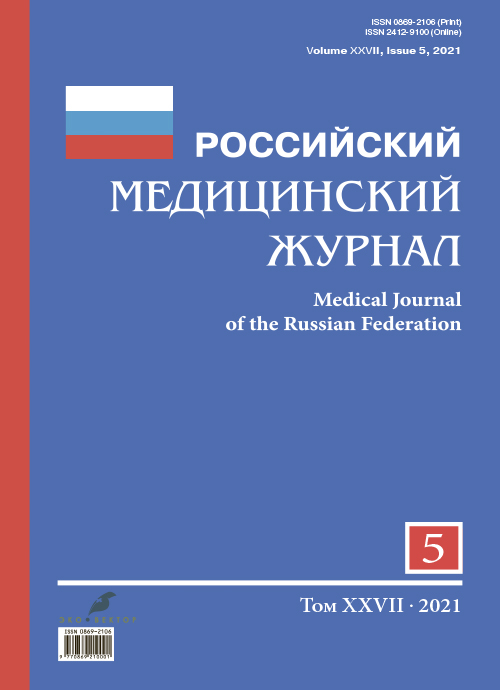Analysis of morphological changes in gallbladder walls after endoscopic bile duct decompression
- Authors: Shabunin A.V.1,2, Tavobilov M.M.1,2, Karpov A.A.1, Ozerova D.S.1,2
-
Affiliations:
- Botkin Hospital
- Russian Medical Academy of Continuous Professional Education
- Issue: Vol 27, No 5 (2021)
- Pages: 465-472
- Section: Clinical medicine
- URL: https://medjrf.com/0869-2106/article/view/83030
- DOI: https://doi.org/10.17816/0869-2106-2021-27-5-465-472
- ID: 83030
Cite item
Abstract
BACKGROUND: In patients who have undergone retrograde endoscopic choledocholithoextraction, technical difficulties are frequently encountered when performing laparoscopic cholecystectomy, which is associated with the development of destructive changes in the gallbladder wall. However, no studies on the assessment of morphological changes occurring in the gallbladder wall at different terms after endoscopic retrograde bile duct interventions are currently available in the literature. The relevance and insufficient knowledge of the research area prompted this study.
AIM: This study aimed to determine the optimal terms of laparoscopic cholecystectomy after endoscopic bile duct decompression performed for cholelithiasis complicated by choledocholithiasis based on morphological changes in the gallbladder wall.
MATERIALS AND METHODS: A comparative analysis of the pathological examination of 198 gallbladders removed surgically on different days after endoscopic bile duct decompression performed for cholelithiasis complicated by choledocholithiasis is presented.
RESULTS: In group 1, cholecystectomy after endoscopic bile duct decompression was performed on days 1–3. Gallbladder wall changes were observed in 10 (12.8%) patients. In group 2, cholecystectomy was performed on days 4–7. Inflammatory changes were revealed in 13 (37.1%) preparations. Pathological examination of the surgical specimens of the patients in group 3 who underwent cholecystectomy on days 14–30 revealed changes in the gallbladder wall in 48 (56.4%) cases.
CONCLUSIONS: Laparoscopic cholecystectomy after endoscopic bile duct decompression within the first 72 h is the most optimal.
Full Text
About the authors
Alexey V. Shabunin
Botkin Hospital; Russian Medical Academy of Continuous Professional Education
Email: info@botkinmoscow.ru
ORCID iD: 0000-0002-4230-8033
SPIN-code: 8917-7732
MD, Dr. Sci. (Med.), Professor, Corresponding member of the Russian Academy of Sciences
Russian Federation, 5, 2nd Botkinsky passage, Moscow, 125184; MoscowMikhail M. Tavobilov
Botkin Hospital; Russian Medical Academy of Continuous Professional Education
Email: botkintmm@yandex.ru
ORCID iD: 0000-0003-0335-1204
SPIN-code: 9554-5553
MD, Dr. Sci. (Med.), assistant professor
Russian Federation, 5, 2nd Botkinsky passage, Moscow, 125184; MoscowAlexey A. Karpov
Botkin Hospital
Email: botkin.karpov@yandex.ru
ORCID iD: 0000-0002-5142-1302
SPIN-code: 9877-4166
MD, Cand. Sci. (Med.)
Russian Federation, 5, 2nd Botkinsky passage, Moscow, 125184Darya S. Ozerova
Botkin Hospital; Russian Medical Academy of Continuous Professional Education
Author for correspondence.
Email: ozerova311@yandex.ru
ORCID iD: 0000-0003-4996-5025
surgeon emergency department №75, graduate student of Surgery Department RMACPS
Russian Federation, 5, 2nd Botkinsky passage, Moscow, 125184; MoscowReferences
- Aboulian A, Chan T, Yaghoubian A, et al. Early cholecystectomy safely decreases hospital stay in patients with mild gallstone pancreatitis: a randomized prospective study. Ann Surg. 2010;251(4): 615–619. doi: 10.1097/SLA.0b013e3181c38f1f
- Bostanci EB, Ercan M, Ozer I, et al. Timing of elective laparoscopic cholecystectomy after endoscopic retrograde cholangiopancreaticography with sphincterotomy: a prospective observational study of 308 patients. Langenbecks Arch Surg. 2010;395(6):661–666. doi: 10.1007/s00423-010-0653-y
- Pardo A, Selman M. Matrix metalloproteases in aberrant fibrotic tissue remodeling. Proc Am Thorac Soc. 2006;3(4):383–388. doi: 10.1513/pats.200601-012TK
- Gorla. Optimal Timing of Laparoscopic Cholecystectomy After Endoscopic Retrograde Cholangiopancreatography. J Curr Surg. 2014;4(2):35–39. doi: 10.14740/jcs230w
- Ercan M, Bostanci EB, Teke Z, et al. Predictive factors for conversion to open surgery in patients undergoing elective laparoscopic cholecystectomy. J Laparoendosc Adv Surg Tech A. 2010;20(5):427–434. doi: 10.1089/lap.2009.0457
- Verhofstad MH, Lange WP, van der Laak JA, et al. Microscopic analysis of anastomotic healing in the intestine of normal and diabetic rats. Dis Colon Rectum. 2001;44(3):423–431. doi: 10.1007/BF02234744
- Ghnnam WM. Early Versus Delayed Laparoscopic Cholecystectomy Post Endoscopic Retrograde Cholangio Pancreatography (ERCP). JSM Gen Surg Cases Images. 2016;(1):1006.
- Salman B, Yilmaz U, Kerem M, et al. The timing of laparoscopic cholecystectomy after endoscopic retrograde cholangiopancreaticography in cholelithiasis coexisting with choledocholithiasis. J Hepatobiliary Pancreat Surg. 2009;16(6):832–836. doi: 10.1007/s00534-009-0169-4
- Sahu D, Mathew MJ, Reddy PK. Outcome in Patients Undergoing Laparoscopic Cholecystectomy Following ERCP; Does Timing of Surgery Really Matter? J Minim Invasive Surg Sci. 2015;4:e25226.
- Coppola R, Riccioni ME, Ciletti S, et al. Analysis of complications of endoscopic sphincterotomy for biliary stones in a consecutive series of 546 patients. Surg Endosc. 1997;11(2):129–132. doi: 10.1007/s004649900314
- Costi R, DiMauro D, Mazzeo A, et al. Routine laparoscopic cholecystectomy after endoscopic sphincterotomy for choledocholithiasis in octogenarians: is it worth the risk? Surg Endosc. 2007;21(1):41–47. doi: 10.1007/s00464-006-0169-2
- Wynn TA. Common and unique mechanisms regulate fibrosis in various fibroproliferative diseases. J Clin Invest. 2007;117(3):524–529. doi: 10.1172/JCI31487
- Tomasek JJ, Gabbiani G, Hinz B, et al. Myofibroblasts and mechano-regulation of connective tissue remodelling. Nat Rev Mol Cell Biol. 2002;3(5):349–363. doi: 10.1038/nrm809
Supplementary files










